The Art of Protest
Sam Kinchin-Smith
The first time I saw one of Kaya Mar’s paintings was at the March for Europe a week after the Brexit vote. I took a picture of him, as did many of the people he walked past: a small man with a neat moustache carrying a peculiar painting, apparently original, of a cart being pulled by a blindfolded donkey towards the edge of the white cliffs of Dover, driven by caricatures of Boris Johnson and Nigel Farage, with tiny naked bodies and beatific faces.
I saw him again at the anti-Trump rally on Whitehall at the end of January, holding aloft a similarly distinctive canvas of the shrunken president wrapped in a soiled American flag, his scowling expression rendered with a precision that made him a much more sympathetic figure than the florid face on everybody else’s placards.
A few weeks ago I went to see him at his house in Ealing. A professional portraitist, Mar was encouraged to ‘try political painting’ by Tony Benn, who sat for him in 2010. His first attempt depicts David Cameron on the toilet, wearing a crown, while Nick Clegg, dressed as a jester, attends on him as Groom of the Stool. Since then Mar has created almost 200 paintings in his spare time – he regards this work as a hobby, and makes no money from it. Half, he told me, are in ‘official buildings’. The rest are stacked up in his garden shed, where I flicked through a surreal highlights reel of the last decade of British politics – George Osborne’s budgets, the Leveson Inquiry, Scottish independence – interspersed with a few international subjects: Putin, Netanyahu, Xi Jinping and Shinzo Abe, Recep Erdoğan as ‘the Turkish Sun King’ and ‘the Ottoman Sultan’ (Mar was born in Turkey).
He paints quickly: a widely circulated picture of Theresa May drowning in a Brexit mire took just an hour and a half to paint. On easels in his living room studio, the works in progress included Angela Merkel losing a climbing contest to Martin Schulz, because of the weight of her refugee policy; Farage, Marine Le Pen, Viktor Orban and Jaroslaw Kaczynski goose-stepping in a beer hall beneath a portrait of Trump; Philip Hammond waving his budget box and sinking into a sea full of underwater mines. When I asked him, last week, if he’d be going to Saturday’s Unite for Europe march, he said yes, and then a couple of days later sent me a scan of his picture for the occasion: of a long-legged Theresa May striding towards the familiar cliff (Mar enthusiastically recycles tropes), her right thigh culminating in the face of Boris Johnson, his hair the hem of her lemon-yellow dress.
The trick, he explained, is to ‘get your disappointment, anger, rage onto the canvas’ with a quick and simple story. ‘Everybody has to recognise what I’m trying to say, not just in England, all over the world … When you try to force meaning, you lose the plot. When you are tribal you censor yourself, and you won’t produce something good.’
Mar sees himself as a ‘cable between public feeling and the canvas’. Less in step with popular opinion is his work’s sympathy for politicians as people – even Trump – evident in the humane, luminous way he paints their faces. He aims to be ‘brutal but not nasty, to attack power not the person’, so strips them of their clothes, leaving them ridiculed but not ‘injured’.
‘As I get older,’ he said, ‘I’m neither left nor right because the more you know, the more you’re disappointed by both.’ While his background and worldview are clearly rooted in the social democratic left, his style has more in common with the satirical traditions of the Spectator or Private Eye. His Tory subjects are, apparently, more gracious than their Labour counterparts in getting the joke. Diane Abbott once called a painting of Merkel in her underwear sexist, so Mar painted Abbott naked in bed with Jeremy Corbyn and his cat, which is reading Das Kapital. Another picture shows a woman who has just given birth recoiling in horror as she’s presented with ‘Labour’s unwanted child’, which has Corbyn’s face, a hammer-and-sickle on its forehead, and a halo.
Mar finds out that rallies are taking place because photo agencies call to ask if they can stage some shots with him and his paintings: ‘Normally they give me two days’ notice, because they like to have me there. I have every one of my pictures on Getty.’ This isn’t a sham; it’s a strategy. Protests ‘haven’t changed anything in all the time I’ve lived here’, Mar said. ‘Politicians love them because they are a valve. But to have your voice heard, you need television and print media.’ And Mar has infiltrated those more effectively than any other satirist I can think of, by feeding the agencies that fuel so much of the media’s output. He can paint whatever he likes, however weird or angry, and Alamy and Shutterstock, the PA and the AP, will guarantee it gets the national platform denied to the protesters he stands alongside.
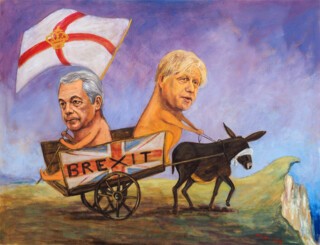
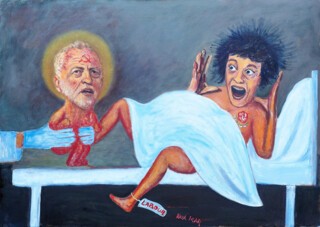
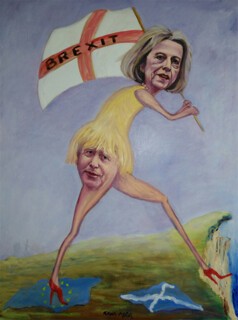
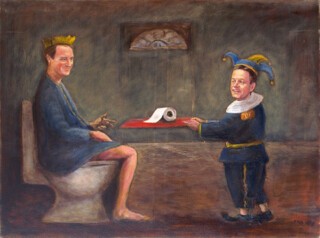
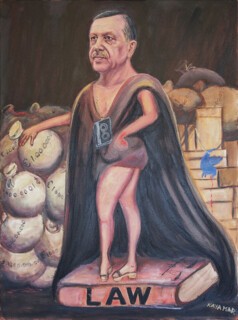
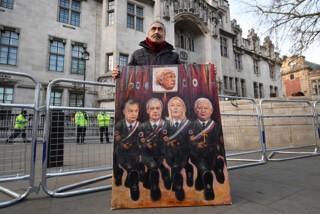
Comments
I went to the candlelit vigil for the Westminster Bridge dead and injured the other day. Many of the attendees were vigil veterans waiting to be interviewed.
I was asked by the "Mail Online" why I was there. I said because it was near. Camberwell, I said, was three miles "that way" and Millwall three miles "that way".
"This is my patch."
I also pointed them to the World War Two wedding-reception incident at Camberwell Green, for context.
https://www.theguardian.com/society/2007/sep/17/secondworldwar
When I got home, I naturally looked for myself in "Mail Online". The vitriolic comments from readers were a bit shocking. "Tealights against terrorists... lefties... snowflakes..."
I was left wondering which is more "real", online or demo, in these days we live in, or seem to live in, or whatever.
https://www.theguardian.com/commentisfree/picture/2017/mar/29/steve-bell-theresa-may-article-50-brexit-cartoon